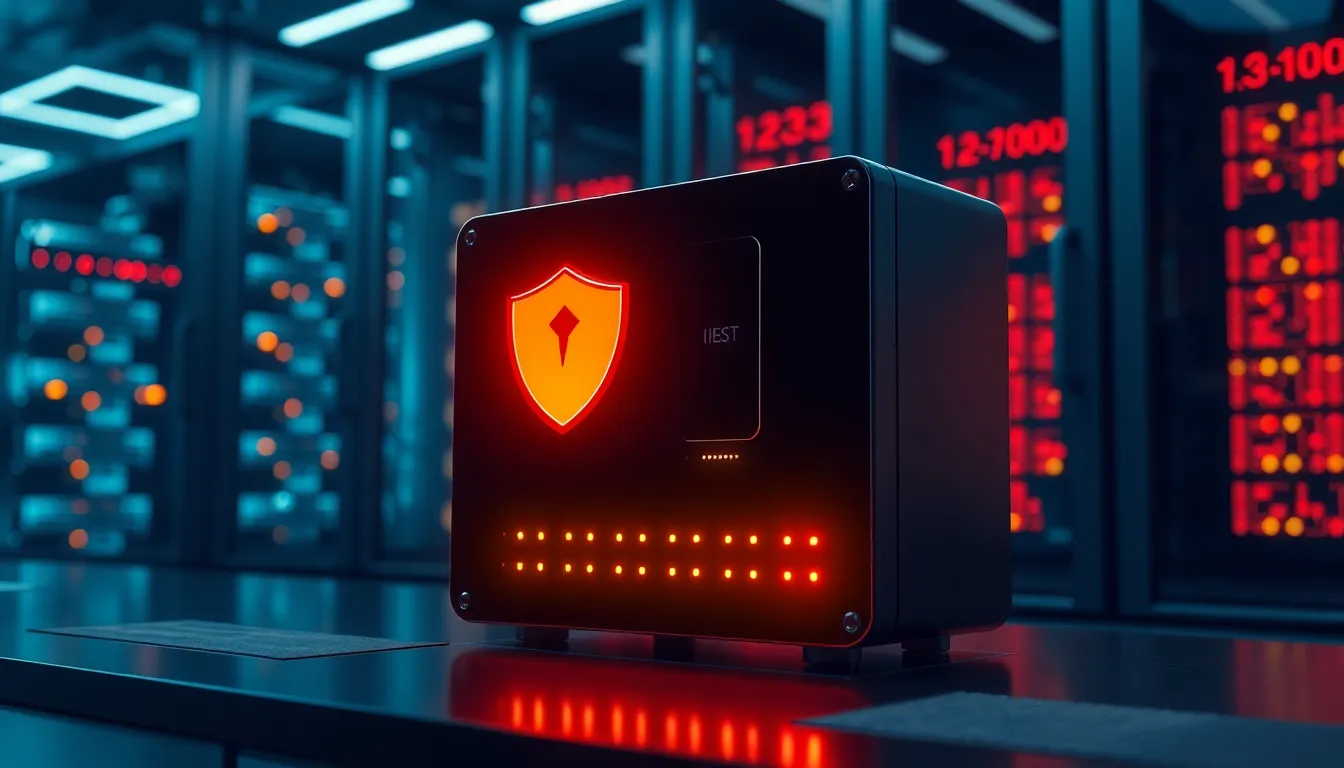In a world where everything from toasters to thermostats is getting smart, the Internet of Things (IoT) is both a blessing and a potential curse. With convenience at our fingertips, the last thing anyone wants is a rogue hacker turning their fridge into a spy device. Enter the IoT firewall, the unsung hero standing guard against cyber villains.
These digital fortresses aren’t just for tech wizards; they’re essential for anyone who values their privacy and sanity. Imagine your smart home working seamlessly while keeping the bad guys out, all thanks to a robust IoT firewall. It’s like having a bouncer for your network, ensuring only the right devices get in. So, let’s dive into the world of IoT firewalls and discover how they can protect your smart devices—and maybe even save your dinner plans from a cyber catastrophe.
Table of Contents
ToggleOverview of IoT Firewalls
IoT firewalls protect networks connected to Internet of Things devices. These firewalls monitor traffic and filter out unauthorized access. Robust security measures prevent cyber threats that exploit vulnerabilities in smart devices.
Specific features include device authentication and traffic encryption. Device authentication verifies identity before allowing connections. Traffic encryption secures data transmitted between devices, safeguarding sensitive information.
IoT firewalls can also segment networks. This segmentation isolates devices from each other, minimizing the impact of a potential breach. Isolation helps limit an attacker’s access to critical systems.
Another important function is real-time monitoring. Continuous oversight tracks unusual activity and detects potential intrusions. Alerts inform administrators of suspicious behavior, enabling quick responses to threats.
Implementing an IoT firewall is essential for both homes and businesses. Vulnerabilities in IoT devices can lead to significant security breaches if left unprotected. Organizations should prioritize robust and adaptive firewall solutions to maintain security as IoT technology evolves.
Integration with existing security protocols enhances overall protection. Layering defenses creates a more comprehensive security posture against emerging threats. Firewall solutions that continuously update can adapt to new vulnerabilities, ensuring sustained protection.
Understanding the specific needs of an IoT environment is vital. Each deployment may require tailored configurations. Awareness of device behaviors and communication patterns aids in creating effective firewall rules.
Ultimately, IoT firewalls act as a critical line of defense. They play an essential role in protecting user privacy and maintaining secure environments for interconnected devices.
Key Features of IoT Firewalls

IoT firewalls provide essential security for devices connected to the internet, protecting users from potential threats and unauthorized access. They incorporate several key features to ensure robust protection.
Security Protocols
Security protocols play a vital role in IoT firewalls. These protocols, such as TLS and DTLS, ensure secure communication between devices. Authentication mechanisms verify device identities before allowing connections. By enforcing encryption standards, firewalls protect data in transit from interception or tampering. Additionally, support for common IoT protocols helps maintain compatibility across various devices, enhancing overall security. Adopting strong security protocols mitigates risks associated with data breaches, ensuring user privacy remains uncompromised.
Threat Detection
Threat detection is crucial for maintaining security in IoT environments. IoT firewalls continuously monitor network traffic for unusual patterns or behaviors. Anomalies trigger alerts that prompt immediate investigation. Machine learning algorithms enhance detection capabilities by learning from historical data and improving response times. Integrating threat intelligence feeds allows firewalls to stay updated on the latest vulnerabilities and emerging threats. Rapid detection and response capabilities help minimize potential damage, reinforcing users’ trust in IoT technologies and their security posture.
Types of IoT Firewalls
IoT firewalls come in various forms, each tailored to enhance the security of interconnected devices. Understanding the differences helps in selecting the right firewall for specific needs.
Hardware Firewalls
Hardware firewalls function as standalone devices designed to protect networked IoT systems. These firewalls act as a barrier between the internal network and external threats, filtering traffic and regulating access points. Often deployed at the network perimeter, hardware firewalls provide robust security by offering features like deep packet inspection and intrusion detection. Organizations can benefit from dedicated resources to handle high volumes of traffic without compromising performance. Additionally, firmware updates ensure ongoing protection against evolving threats, making these firewalls essential for maintaining a secure network.
Software Firewalls
Software firewalls operate at the application level and integrate directly into individual devices. By monitoring outgoing and incoming traffic, these firewalls enable specific rules tailored to protect discreet devices. Customization enhances security for unique IoT applications, allowing users to define access controls based on device behavior. Commonly employed in both personal and enterprise environments, software firewalls offer flexibility and ease of installation. Updates can be rolled out swiftly, adapting to new vulnerabilities as they arise. Equipped with real-time monitoring features, software firewalls provide critical insights into device activity, ensuring timely responses to potential threats.
Benefits of Implementing IoT Firewalls
Implementing IoT firewalls offers several advantages that enhance the security of connected devices. Protection against unauthorized access remains a primary benefit, as these firewalls filter incoming and outgoing traffic, ensuring legitimate devices are the only ones that can access networks.
Increased visibility into network traffic is another significant advantage. Firewalls monitor interactions between devices and provide real-time insights, empowering users to detect unusual patterns that may signal cyber threats. Quick identification of security issues allows for prompt responses, minimizing potential damage.
Enhanced device authentication serves as a critical feature as well. By verifying identities before connections, IoT firewalls help maintain a secure environment where only trusted devices communicate. This process reduces the risk of breaches caused by compromised devices.
Segmenting networks stands out as a strategic approach to improving overall security. By isolating devices, potential threats become contained, and attackers face limited access to essential systems. This measure significantly mitigates the impact of a breach, safeguarding sensitive data.
Data encryption also plays a vital role in enhancing security measures. Protecting data in transit ensures that information shared among devices remains confidential, reducing the risk of interception. The usage of strong encryption protocols contributes further to maintaining user trust in IoT technologies.
Finally, compatibility with various IoT protocols enhances the adaptability of firewalls. By integrating easily with existing devices, organizations can leverage their current infrastructure while maximizing security. This flexibility is essential for evolving IoT ecosystems, where new devices frequently connect to existing networks.
Prioritizing the implementation of IoT firewalls leads to a fortified security posture, ultimately protecting user privacy and securing interconnected devices against emerging threats.
Challenges in IoT Firewall Deployment
Deploying IoT firewalls presents several challenges that organizations must address. Scalability remains a significant concern, as networks expand and the number of connected devices increases. Ensuring that firewalls can handle this growth without compromising performance is critical.
Complexity also adds to the difficulty of deployment. Organizations often encounter a variety of IoT devices with differing protocols and security requirements. Integrating firewalls into existing networks while accommodating these diverse requirements demands careful planning and expertise.
Another challenge arises from the persistent evolution of cyber threats. Attackers continuously develop new techniques to exploit vulnerabilities in IoT devices. Keeping firewalls updated to respond to these emerging threats requires ongoing attention and resources.
Device visibility can be problematic when deploying firewalls. Many IoT devices operate in a decentralized manner, making it hard to monitor all network traffic effectively. Gaining complete visibility into device activities is essential for accurate threat detection and response.
Costs also play a role in the deployment of IoT firewalls. Budget constraints can limit the capabilities of security solutions. Organizations often need to balance cost considerations with the necessity of robust security measures.
User education remains crucial as well. Employees may not be fully aware of security best practices related to IoT devices. Educating staff can enhance overall security posture but demands time and resources on the part of organizations.
In addition to these challenges, compatibility issues between IoT firewalls and existing infrastructure can arise. Ensuring seamless integration may involve significant adjustments to current systems, creating potential roadblocks during deployment. By recognizing and addressing these challenges, organizations can better safeguard their IoT ecosystems against evolving security threats.
Investing in IoT firewalls is essential for anyone looking to secure their smart devices. These firewalls not only filter unauthorized access but also provide real-time monitoring and threat detection. By implementing robust security measures, users can significantly reduce the risk of cyber threats while enhancing their privacy.
As the IoT landscape continues to evolve, so do the challenges associated with it. Organizations must remain vigilant and proactive in adopting advanced firewall solutions that can adapt to emerging threats. Ultimately, prioritizing IoT firewalls will lead to a more secure and resilient network environment, allowing users to enjoy the benefits of connected devices without compromising their safety.




